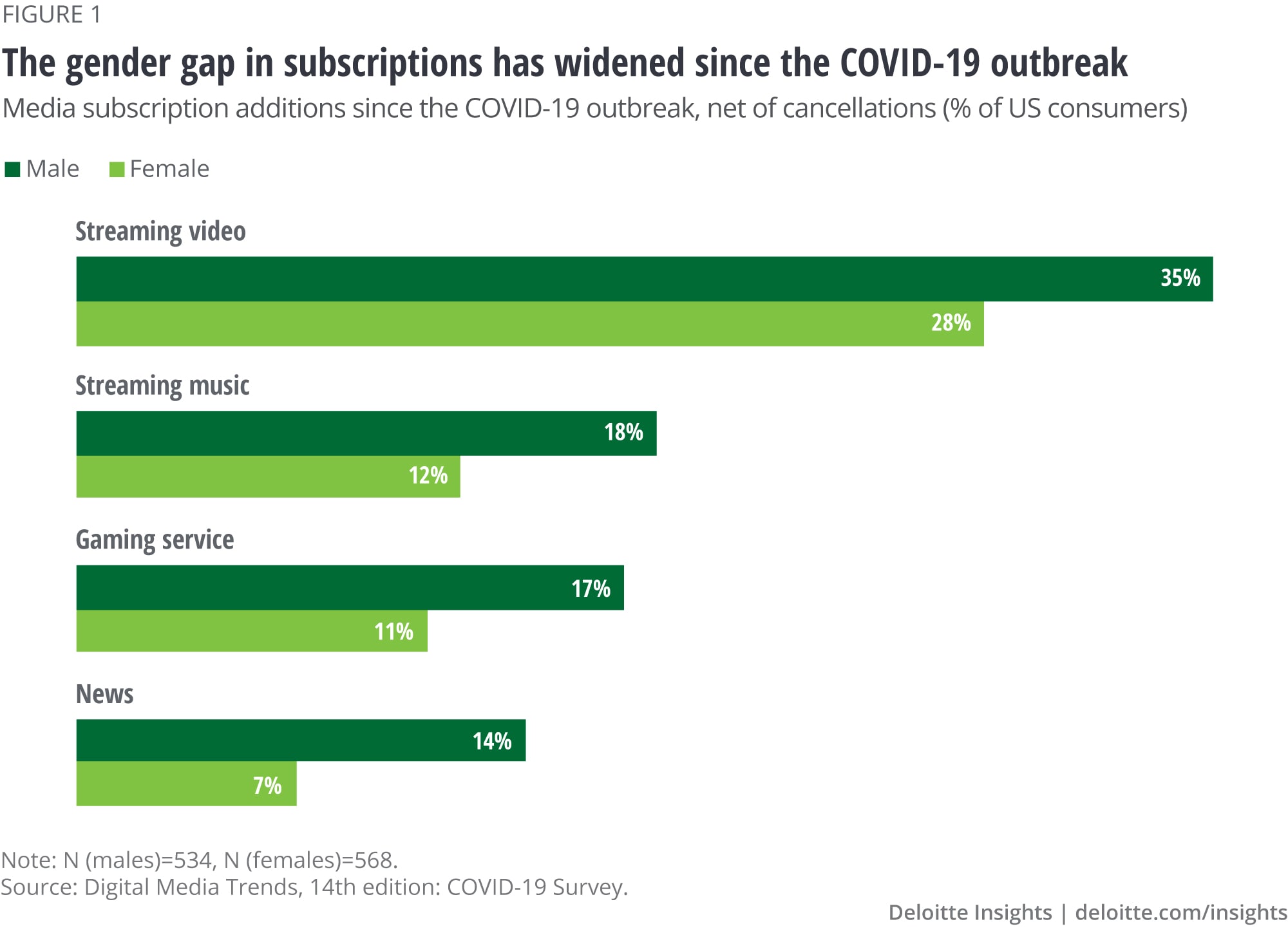Should media and entertainment companies focus on female consumers to boost subscriptions? Since the pandemic began, men are adding more media subscriptions— and women’s needs are changing
3 minute read
10 October 2020
Men have more media subscriptions than women, and COVID-19 has widened the gap. Lower costs and bundled services could help close it.

As media and entertainment (M&E) companies battle to attract and retain customers for their subscription services, they may need to focus on the changing needs of women during COVID-19.
Learn more
Explore the Thinking Fast series library
Subscribe and never miss a charticle
Learn about Deloitte's services
Go straight to smart. Get the Deloitte Insights app
In the 14th edition of our Digital media trends survey, we found that consumers accessed an average of 12 paid media subscriptions. This average concealed a substantial gender gap: Male consumers had 14 subscriptions, compared to 10 for females.1 Men averaged one more subscription than women in four media and entertainment categories: gaming services, audiobooks, news, and magazines.
Since the onset of COVID-19, the subscription gap has widened further. Men have added more subscriptions, net of cancelations, for every major streaming category: video, music, and video games (see figure). The same is true of news subscriptions.
A deeper look into streaming video subscriptions can help reveal the differences between men and women, and the opportunity for M&E companies.
Men are more likely than women to sign up for services—and to cancel them. For example, 20 percent of men canceled a streaming video subscription during the pandemic, compared to 13 percent of women. Men are twice as likely as women (22 percent to 11 percent) to drop a streaming video service so they can subscribe to a new one. Yet while their churn rate is higher, since COVID-19, men have five streaming video services on average, while women have four.
In short, M&E companies need male consumers to stay committed, and they need more women to commit in the first place.
COVID-19 could make this task more challenging. The pandemic has affected women and their finances disproportionately.2 Forty-two percent of women in our survey said their household lost income since COVID-19, seven percentage points higher than men. Women are also experiencing higher rates of unemployment,3 and many have cut work hours to care for family members.4 And on average, women make 82 cents for every dollar earned by men.5
Perhaps for this reason, many women in our survey were cost-conscious. Seventy-six percent of women who canceled a streaming video service during COVID-19 cited cost issues6—seven percentage points higher than men who cut.
There’s another potential issue: lack of free time. Fifty-nine percent of men who added a subscription video service said they did so because they had more time to watch content. For women—many of whom have seen their childcare and home responsibilities increase since COVID-197—the number was 44 percent.
Implications for executives
M&E executives should consider the following steps to encourage women to sign up for subscriptions—and to engage with those who don’t want the commitment.
Develop tiered services. To gain female subscribers, M&E companies may need to roll out low-cost options, including more tiered services, offering subscription levels to fit a wider range of budgets and interests.
Aggregate subscriptions. All-in-one subscription services that combine streaming video, music, gaming, news, and other services can reduce both costs and “subscription fatigue”—the time and effort it takes to manage multiple services. For example, one subscription service aims to offer three pricing tiers, including one that offers live fitness classes.
Promote ad-supported options. When asked how they’d like to access a streaming video service with content they knew they wanted, 48 percent of women preferred a free ad-supported option, compared to 38 percent of men.8 Yet when it comes to actual viewership, the numbers are nearly reversed: 51 percent of men and 43 percent of women watch ad-supported streaming services such as Pluto TV. Promoting these services with women could help M&E companies increase engagement and revenue without relying on subscriptions.
© 2021. See Terms of Use for more information.
More from the Thinking Fast charticle series
-
Will gaming keep growing when the lockdowns end? Article4 years ago
-
The most valued technology gadgets of the last decade Article5 years ago
-
Can tech companies reach older consumers during the pandemic? Article4 years ago
-
How streaming is changing the music industry Article4 years ago
-
Why organizations are moving to the cloud Article5 years ago
-
The changing face of North America’s tech ecosystem Article5 years ago














